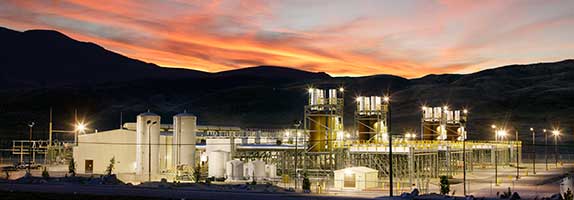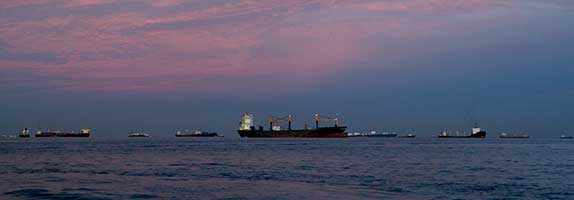


Wärtsilä report shows an area the size of Europe will need to be covered with renewable power to reach a clean energy future, without the integration of balancing power technologies.
Wärtsilä’s global power system modelling, published in the Crossroads to net zero report, compares two pathways from the year 2025 to 2050 with the aim to reduce greenhouse gas emissions and limit global warming, as per the Paris Agreement targets. In the first pathway, only renewables, such as wind and solar power, and energy storage are added to the power mix. In the second pathway, balancing power generation technologies, that can be ramped up quickly when needed to support intermittent renewables, are also added to the system.
The modelling shows that a power system including balancing power has significant advantages when it comes to both cost and CO₂ reductions. The model reveals that this pathway would generate cumulative savings of EUR 65 trillion by 2050 compared to a renewables-only pathway, due to less renewable capacity needed. This would average EUR 2,5 trillion per year – an equivalent to over 2% of 2024’s global GDP.
The report outlines that the effectiveness of renewables can be maximised if supported by balancing power plants, which are key in scaling up renewable energy.
Key findings:
1. Reduced costs: The study shows that compared to a renewables and energy storage-only pathway, the deployment of balancing power plants will reduce the cost of future power systems by as much as 42%, equalling EUR 65 trillion
2. Reduced emissions: Adding balancing power can reduce the total cumulative power sector CO₂ emissions between now and 2050 by 21% (19 Gt), compared to the renewables and storage-only path
3. Less wasted energy: The modelling shows that the use of balancing power allows for enhanced power system optimisation, resulting in 88% less wasted energy due to renewable curtailment by 2050, compared with a renewable and energy storage-only pathway. In total, 458 000 TWh of curtailments would be avoided, enough to power the whole world with the current electricity consumption for more than 15 years
4. Less renewable capacity and land needed: By adding balancing power plants, we can halve renewable capacity and land needed to meet our decarbonisation targets.
Håkan Agnevall, CEO and President of Wärtsilä, says:
"Our modelling shows that there is a viable and cost-efficient path to decarbonise the power sector."
"We have all the technologies we need to accelerate the shift to renewables-led power systems – but going green is not black or white. Renewable-led power systems require flexibility in various forms: energy storage alongside balancing power plants utilising gas as a transition fuel, before sustainable fuels are available, are critical to reach global climate goals."
Calls to action for the power sector
Decisive actions from the entire power sector are crucial to achieve a low-cost and low-emission energy transition in line with the 2050 Paris Agreement. Instead of only focusing on the acceleration of renewable build up, a holistic system level thinking must be in place when investing in and planning power systems.
1. Enable accelerated expansion of renewables and balancing technologies to ensure affordable electricity
2. Redesign electricity markets to incentivise flexibility
3. Choose the right future proof technologies and prepare for sustainable fuels
Anders Lindberg, President Wärtsilä Energy & Executive Vice President, says:
"While we have more renewable energy on our grids than ever before, it is not enough on its own. To achieve a clean energy future, our modelling shows that flexibility is essential."
"We need to act now to integrate the right levels and types of balancing technologies into our power systems. This means rapidly phasing out inflexible assets and transitioning to sustainable fuels. Balancing power plants are not merely important; they are critical in supporting higher levels of renewable energy."
Notes to editors
Contrasting choice of net-zero pathways: In this study, we define two contrasting pathways between the period 2025-2050 to achieve net zero power systems, with an end goal to better understand the options and approaches for viable decarbonisation.
Pathway 1: Renewables and storage
In the Renewables and storage pathway, power sector expansion relies exclusively on variable renewable energy (VRE) and energy storage systems (ESS). Existing power plants are gradually decommissioned by 2040 but are allowed to operate within emission limits until retirement. No new power generation capacity except for renewables and energy storage systems is introduced during the modelling horizon.
Pathway 2: Balanced
In the Balanced pathway, expansion is also led by renewable energy and energy storage systems, but with the addition of balancing power plants that provide additional flexibility and enhance system performance. These are enabled for sustainable fuels that are expected to become more widely available in the 2030s. Existing inflexible power plants are gradually replaced with new capacity upon retirement. Capacity additions for nuclear, biofuels, and coal and gas plants with carbon capture and storage (CCS), follow conservative projections from publicly available sources, such as International Energy Agency (IEA) and International Atomic Energy Agency (IAEA).
Methodology: The analyses in the Crossroads to net zero report are based on techno-economic optimisation to determine the least-cost capacity mix required to meet future electricity demand while adhering to emission limits and other political constraints. Conventional power plants are included with their technical specifications and fuel sources to accurately model their emissions and role in balancing variable renewable generation. Wind and solar generation are modelled using hourly profiles based on weather data.
This detailed optimisation uses a chronological approach, balancing the variability of renewable generation and load on an hour-by-hour basis from 2023 to 2050. The model co-optimises system expansion with dispatch, using a one-hour resolution to capture load and renewable generation patterns in high detail.
The global power system is aggregated into a single model, aligning various regional power profiles to preserve daily patterns such as demand peaks and solar output regularity. This aggregated approach avoids time-zone discrepancies that could distort demand and generation profiles.
Learn more: www.wartsila.com/energy/crossroads-to-net-zero
Media kit
Media contact:
Katri Pehkonen
Communications Manager
Wärtsilä Energy
Mob: +358 50 591 6180
katri.pehkonen@wartsila.com
Image caption: Wärtsilä’s global power system modelling, published in the Crossroads to net zero report, compares two pathways from the year 2025 to 2050 with the aim to reduce greenhouse gas emissions and limit global warming, as per the Paris Agreement targets. © Wärtsilä
All Wärtsilä releases are available at www.wartsila.com/media/news-releases and at news.cision.com/wartsila-corporation where also the images can be downloaded. Use of the image(s) is allowed only in connection with the contents of this press release. Wärtsilä images are available at www.wartsila.com/media/image-bank.
Wärtsilä Energy in brief
Wärtsilä Energy is at the forefront of the transition towards a 100% renewable energy future. We help our customers and the power sector to accelerate their decarbonisation journeys through our market-leading technologies and power system expertise. Our solutions include flexible engine power plants, energy storage and optimisation technology, and services for the whole lifecycle of our installations. Our engines are future-proof and can run on sustainable fuels. Our track record comprises 79 GW of power plant capacity, of which 18 GW are under service agreements, and over 125 energy storage systems, in 180 countries around the world.
www.wartsila.com/energy
Wärtsilä in brief
Wärtsilä is a global leader in innovative technologies and lifecycle solutions for the marine and energy markets. We emphasise innovation in sustainable technology and services to help our customers continuously improve environmental and economic performance. Our dedicated and passionate team of 17,800 professionals in more than 280 locations in 79 countries shape the decarbonisation transformation of our industries across the globe. In 2023, Wärtsilä’s net sales totalled EUR 6.0 billion. Wärtsilä is listed on Nasdaq Helsinki.
www.wartsila.com